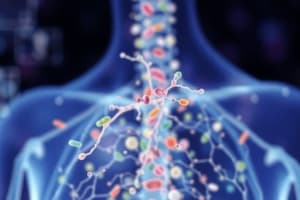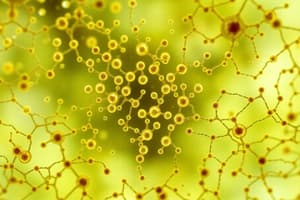Podcast
Questions and Answers
What is the primary purpose of metagenomics techniques?
What is the primary purpose of metagenomics techniques?
- To sequence all genomic DNA present in a sample (correct)
- Identify different types of microbes on human skin
- Enhance the immune response in humans
- Determine antibiotic resistance in microbial communities
Which microbial phyla predominantly inhabit the skin according to the classification mentioned?
Which microbial phyla predominantly inhabit the skin according to the classification mentioned?
- Firmicutes
- Bacteroidetes
- Lactobacillus
- Actinobacteria (correct)
What is inferred about metabolic activities based on metagenomics?
What is inferred about metabolic activities based on metagenomics?
- They can be inferred from the genes present. (correct)
- Only microbial diversity can be observed.
- No relation exists between genes and metabolic activities.
- Metabolic activities cannot be accurately determined.
How do microbial communities differ across body habitats?
How do microbial communities differ across body habitats?
What is the significance of removing human sequences in metagenomics?
What is the significance of removing human sequences in metagenomics?
Which bacteria predominate in the gut according to the described microbial distribution?
Which bacteria predominate in the gut according to the described microbial distribution?
What is one of the key questions addressed in the study of the human microbiome?
What is one of the key questions addressed in the study of the human microbiome?
Which of the following statements best describes the change in microbial communities over time?
Which of the following statements best describes the change in microbial communities over time?
What is the primary function of Lactobacillus in the vaginal microbiome?
What is the primary function of Lactobacillus in the vaginal microbiome?
Which statement about the gut microbiome is correct?
Which statement about the gut microbiome is correct?
Which bacterial family is reduced due to circumcision in the penis microbiome?
Which bacterial family is reduced due to circumcision in the penis microbiome?
What is a common feature of the oral cavity microbiome when teeth are present?
What is a common feature of the oral cavity microbiome when teeth are present?
What role do the metabolic by-products of skin bacteria play?
What role do the metabolic by-products of skin bacteria play?
How do delivery methods influence microbiome acquisition?
How do delivery methods influence microbiome acquisition?
In which environment are most skin bacteria found?
In which environment are most skin bacteria found?
Which group of bacteria is predominantly associated with tooth decay?
Which group of bacteria is predominantly associated with tooth decay?
What factors can alter the colonization succession of the gut microbiome in the first three years of life?
What factors can alter the colonization succession of the gut microbiome in the first three years of life?
What type of life changes can lead to modifications in the microbiome?
What type of life changes can lead to modifications in the microbiome?
What is observed in the dynamics of daily activity measurements in the small cohort studied?
What is observed in the dynamics of daily activity measurements in the small cohort studied?
Over one year, what percentage of Subject A’s saliva microbiota samples contained the identified core operational taxonomic units (OTUs)?
Over one year, what percentage of Subject A’s saliva microbiota samples contained the identified core operational taxonomic units (OTUs)?
What percentage of total counted bacteria does the small subset of highly abundant core taxa represent during stable periods?
What percentage of total counted bacteria does the small subset of highly abundant core taxa represent during stable periods?
What method was primarily used to measure the dynamics of gut and oral microbial communities?
What method was primarily used to measure the dynamics of gut and oral microbial communities?
During stable periods, what are the core OTUs characteristic of?
During stable periods, what are the core OTUs characteristic of?
How does exposure to antibiotics affect the gut microbiome during early life?
How does exposure to antibiotics affect the gut microbiome during early life?
What is the process used to obtain real axenic mice?
What is the process used to obtain real axenic mice?
What does the term 'gnotobiotic' mean?
What does the term 'gnotobiotic' mean?
What percentage of shared bacterial species exists between axenic mice and regular mice?
What percentage of shared bacterial species exists between axenic mice and regular mice?
What is the relationship between humans and their microbiota described as?
What is the relationship between humans and their microbiota described as?
What is one of the major questions in studying the human microbiome?
What is one of the major questions in studying the human microbiome?
What event does the study titled 'The active human gut microbiota and its phage regulators in health and disease' aim to explore?
What event does the study titled 'The active human gut microbiota and its phage regulators in health and disease' aim to explore?
What is indicated as a task for participants in the microbiome study?
What is indicated as a task for participants in the microbiome study?
Which of the following is NOT a role of microbial cells in human health mentioned?
Which of the following is NOT a role of microbial cells in human health mentioned?
What is the primary focus of the study regarding infant health?
What is the primary focus of the study regarding infant health?
Which microorganisms are established first in the infant's microbiome?
Which microorganisms are established first in the infant's microbiome?
What is the predominant type of bacteria in an infant's microbiome after six months?
What is the predominant type of bacteria in an infant's microbiome after six months?
What demographic did the study involve for analyzing microbiome development?
What demographic did the study involve for analyzing microbiome development?
What is a key method of data collection in this study?
What is a key method of data collection in this study?
What type of ethical approval was required for the study?
What type of ethical approval was required for the study?
At what age does the infant's microbiota transition to resemble adult-like microbiota?
At what age does the infant's microbiota transition to resemble adult-like microbiota?
What aspect of cesarean delivery is implied to have an impact on the microbiome according to the study?
What aspect of cesarean delivery is implied to have an impact on the microbiome according to the study?
What constitutes the human microbiome?
What constitutes the human microbiome?
What is the relative number of human cells compared to microbiota cells in the human body?
What is the relative number of human cells compared to microbiota cells in the human body?
What does the term 'holobiome' refer to?
What does the term 'holobiome' refer to?
Which option is NOT an important question regarding the human microbiome?
Which option is NOT an important question regarding the human microbiome?
What is the approximate weight of microbiota in humans?
What is the approximate weight of microbiota in humans?
How many genes does the human microbiome consist of approximately?
How many genes does the human microbiome consist of approximately?
Why is it important to study the human microbiome?
Why is it important to study the human microbiome?
Which population in the human body does NOT include the microbiome?
Which population in the human body does NOT include the microbiome?
What has driven the 'microbiome revolution' in research?
What has driven the 'microbiome revolution' in research?
What is true about the evolution of research into the microbiome?
What is true about the evolution of research into the microbiome?
What role do microorganisms play in human health?
What role do microorganisms play in human health?
What is a key characteristic of symbiosis in the human microbiome?
What is a key characteristic of symbiosis in the human microbiome?
Which of the following statements about human genome and microbiome is correct?
Which of the following statements about human genome and microbiome is correct?
What type of studies are crucial for translating findings from animal models to humans regarding the microbiome?
What type of studies are crucial for translating findings from animal models to humans regarding the microbiome?
Flashcards
Metagenomics
Metagenomics
A technique for sequencing all genetic material (DNA or RNA) in a sample, including from multiple organisms.
Human Microbiome
Human Microbiome
The collection of all microorganisms (bacteria, viruses, fungi) that live in and on the human body.
Microbial communities cluster by body site
Microbial communities cluster by body site
Microbial communities differ significantly based on their location in the body.
Actinobacteria on Skin
Actinobacteria on Skin
Signup and view all the flashcards
Lactobacillus in Vagina
Lactobacillus in Vagina
Signup and view all the flashcards
Bacteroidetes and Firmicutes in Gut
Bacteroidetes and Firmicutes in Gut
Signup and view all the flashcards
Streptococcus in Mouth
Streptococcus in Mouth
Signup and view all the flashcards
Antibiotics and Microbial Community Change
Antibiotics and Microbial Community Change
Signup and view all the flashcards
What are the dominant bacterial phyla in the gut microbiome?
What are the dominant bacterial phyla in the gut microbiome?
Signup and view all the flashcards
What is the main purpose of Lactobacillus in the vagina?
What is the main purpose of Lactobacillus in the vagina?
Signup and view all the flashcards
Why is the gut microbiome considered mostly anaerobic?
Why is the gut microbiome considered mostly anaerobic?
Signup and view all the flashcards
How does the microbiome change after delivery?
How does the microbiome change after delivery?
Signup and view all the flashcards
What is a proxy sample for analyzing the gut microbiome?
What is a proxy sample for analyzing the gut microbiome?
Signup and view all the flashcards
How does circumcision impact the penis microbiome?
How does circumcision impact the penis microbiome?
Signup and view all the flashcards
Where is the majority of the human microbiome located?
Where is the majority of the human microbiome located?
Signup and view all the flashcards
What are volatile fatty acids and how are they related to body odor?
What are volatile fatty acids and how are they related to body odor?
Signup and view all the flashcards
What is the Human Microbiome?
What is the Human Microbiome?
Signup and view all the flashcards
Microbiota vs Microbiome
Microbiota vs Microbiome
Signup and view all the flashcards
How many cells are in the Human Body?
How many cells are in the Human Body?
Signup and view all the flashcards
How many microbial cells are in the Human Body?
How many microbial cells are in the Human Body?
Signup and view all the flashcards
How does the number of genes in the Human Microbiome compare to the Human Genome?
How does the number of genes in the Human Microbiome compare to the Human Genome?
Signup and view all the flashcards
What is the Holobiome?
What is the Holobiome?
Signup and view all the flashcards
Symbiosis Spectrum
Symbiosis Spectrum
Signup and view all the flashcards
What is the Human Microbiome Revolution?
What is the Human Microbiome Revolution?
Signup and view all the flashcards
How did the Human Microbiome Revolution begin?
How did the Human Microbiome Revolution begin?
Signup and view all the flashcards
Why is the Human Microbiome Important for Health?
Why is the Human Microbiome Important for Health?
Signup and view all the flashcards
How is the Human Microbiome Studied?
How is the Human Microbiome Studied?
Signup and view all the flashcards
Why are animal models important in studying the Human Microbiome?
Why are animal models important in studying the Human Microbiome?
Signup and view all the flashcards
What are the major questions about the Human Microbiome?
What are the major questions about the Human Microbiome?
Signup and view all the flashcards
Critical window for gut microbiome
Critical window for gut microbiome
Signup and view all the flashcards
Factors influencing microbiome changes
Factors influencing microbiome changes
Signup and view all the flashcards
Microbiome dynamics over time
Microbiome dynamics over time
Signup and view all the flashcards
Long-term microbiome stability
Long-term microbiome stability
Signup and view all the flashcards
Core microbiome taxa
Core microbiome taxa
Signup and view all the flashcards
Saliva microbiome stability
Saliva microbiome stability
Signup and view all the flashcards
Microbiome research limitations
Microbiome research limitations
Signup and view all the flashcards
Ongoing microbiome research
Ongoing microbiome research
Signup and view all the flashcards
Baby's Delivery Mode
Baby's Delivery Mode
Signup and view all the flashcards
Mother's Body Habitat
Mother's Body Habitat
Signup and view all the flashcards
Microbiome Succession
Microbiome Succession
Signup and view all the flashcards
Facultative Anaerobes
Facultative Anaerobes
Signup and view all the flashcards
Obligate Anaerobes
Obligate Anaerobes
Signup and view all the flashcards
Infant Microbiome Development
Infant Microbiome Development
Signup and view all the flashcards
Effects of Microbiome Shifts
Effects of Microbiome Shifts
Signup and view all the flashcards
Prospective Studies
Prospective Studies
Signup and view all the flashcards
What are axenic mice?
What are axenic mice?
Signup and view all the flashcards
What's the difference between axenic and gnotobiotic mice?
What's the difference between axenic and gnotobiotic mice?
Signup and view all the flashcards
Why are microbiota-associated mouse models important?
Why are microbiota-associated mouse models important?
Signup and view all the flashcards
What is a holobiont?
What is a holobiont?
Signup and view all the flashcards
What is the difference between the human microbiome and microbiota?
What is the difference between the human microbiome and microbiota?
Signup and view all the flashcards
How do gut microbes impact our health?
How do gut microbes impact our health?
Signup and view all the flashcards
What are some major research questions about the human microbiome?
What are some major research questions about the human microbiome?
Signup and view all the flashcards
What is the focus of the study advertised?
What is the focus of the study advertised?
Signup and view all the flashcards
Study Notes
The Human Microbiome
-
The human microbiome is a complex ecosystem of microbes residing on and within the human body.
-
Humans are comprised of eukaryotes, bacteria, archaeabacteria, viruses, and parasites.
-
Human cells number approximately 1013, while the microbiota (cells) is estimated at 1-3x1013.
-
The human genome has approximately 20,000-25,000 genes. The microbiome has approximately 23,000,000 genes.
-
The weight of the microbiota is approximately 0.2 kg compared to a total body weight of 70kg.
Studying the Microbiome
-
Traditionally, culture-based methods were used to study the microbiome. Most bacterial cells are not easily cultured using current methods leading to the "Great Plate Count Anomaly".
-
Culture-independent methods are now used. These methods include 16S rDNA sequencing to identify species.
-
Deep genomic sequencing, or metagenomics, reveals the genes present. Metagenomics lets us infer metabolic activities.
-
mRNA sequencing (metatranscriptomics) reveals which genes are actively expressed, and therefore, metabolic activities.
-
Metabolomics studies the metabolites produced by the microbiome.
Microbial Communities
-
Microbial communities are highly site-specific.
-
Different body sites have different dominant bacterial phyla.
-
Examples include the skin, vagina, gut, and oral cavity, each with distinct microbial populations.
How Do We Acquire A Microbiome?
- The fetus was previously considered sterile before birth.
- A large number of microbes are acquired after birth.
- Colonization patterns vary with delivery method (vaginal vs. C-section).
Microbiome Changes Over Time
-
The first three years of life are characterized by significant microbiome shifts.
-
Factors influencing the microbiome include:
-
the type of feeding (breast milk vs. formula)
-
the environment
-
exposures such as pets, antibiotics, and travel
-
lifestyle changes such as transitions to solid food.
-
Microbiomes tend to stabilize into adult-like profiles by age three, and change further continuously following life events.
How To Establish Causation/Interventions
-
In vitro, animal, and human studies help establish causation.
-
Each model has certain limitations.
Models Used To Study The Microbiome
-
Mouse models offer controlled conditions to study the microbiome and the effect of various variables.
-
Germ-free mice (axenic mice) are useful as control models.
-
Gnotobiotic mice are increasingly used by introducing specific microbes into germ-free mice.
Other Topics
-
The human microbiome contributes greatly to human health by training the immune system, aiding in digestion, and protecting against pathogens.
-
The human microbiome is sometimes linked to disease.
-
The "holobiont" is a biological unit encompassing the host and its microbial community.
Studying That Suits You
Use AI to generate personalized quizzes and flashcards to suit your learning preferences.




